|
|
Post by codystarbuck on Jul 9, 2021 20:06:50 GMT -5
You are a better man than me Gunga Din. I stopped following after issue 11. Remember flipping through 12 and 13, maybe even 14 and going mmmmnnnnnnnaaaaaahh, nothing for me anymore. Really laughed out loud too in seeing Munro's new outfit. Yeah, well, Gunga Din is being mauled by the thugee and is losing his will to live, with this series. I'm hoping Ultra-Humanite can stir some stuff up and I've been curious to see what was actually in the Dyzan Inheritance storyline, for a while. I don't know if Roy was suffering from burnout, by this point, disappointment with how things had been going at DC or what; but, this is really substandard stuff, for him. The latter third of All-Star Squadron wasn't anywhere near as good as the first third or the middle third; but, there was still some entertainment in it. I never read Arak, so I can't comment; but, Infinity, Inc had really lost its momentum and it had a lot of fits and starts, and a bit too much wallowing in old All-Star stories. This just isn't really creating interesting characters. I like tying Arn to Hugo Danner; but, so far, that is his most interesting feature. Dyna-Mite is a generic mascot/kid sidekick type and the resident cheerleader and that is about it. Fury has potential. Flying Fox is too much of a stereotype, for me, though he is at least not speaking pigeon English. Otherwise, he's pretty bland, with ill-defined powers. Neptune Perkins is even blander than Aquaman, of the period. Tsunami at least has her ethnic background to provide some drama. Quite frankly, Roy did better work on Hero Comics' Captain Thunder and Blue Bolt and very few people ever saw that (their loss, in my opinion) What really bugs me is the art. It looks so amateurish, even with Malcolm Jones cleaning things up. All-Star had Rich Buckler, Adrian Gonzales and Jerry Ordway, giving it a nice look for the first few years. When Ordway left, you hade Rick Hoberg, Richard Howell and Arvell Jones, which was a bit of a comedown; but, they handled the period well and were good storytellers. Howard Simpson just doesn't wow me enough to care for Roy's rather tired stories and thinly sketched characters. The series only ran 31 issues and an annual (which crossed over with Infinity, Inc); so, I'll stick it out; but, like I said, I might start accelerating if the stories don't get more interesting. |
|
|
|
Post by codystarbuck on Jul 22, 2021 14:11:32 GMT -5
Young All-Stars #14 Young All-Stars vs Ol' T-Rex! (That's Marc Bolan inside the dinosaur!) Creative Team: Roy & Dann Thomas-writers, Howard Simpson-pencils, Malcolm Jones III-inks, Jean Simek-letters, Gene D'Angelo-colors, Mark Waid-Associate editor (gopher) Waid got his first credit as associate editor last issue. Synopsis: Arn wakes up, buck nekkid, in Project M and is told his body is healing, after Tsiphone ripped him a new one, but his butt-ugly costume didn't survive, coincidentally. When he hears Tsiphone left, he wants to go after, but needs some new duds. We are reminded that he is mostly impervious to harm, excepting for a bursting artillery shell (the explosive force or the shrapnel?). Meanwhile, Deathbolt threatens Per Degaton to get him out of there or he squeals about Deggie's part in getting him in. He sabotages things so Deathbolt can get loose. 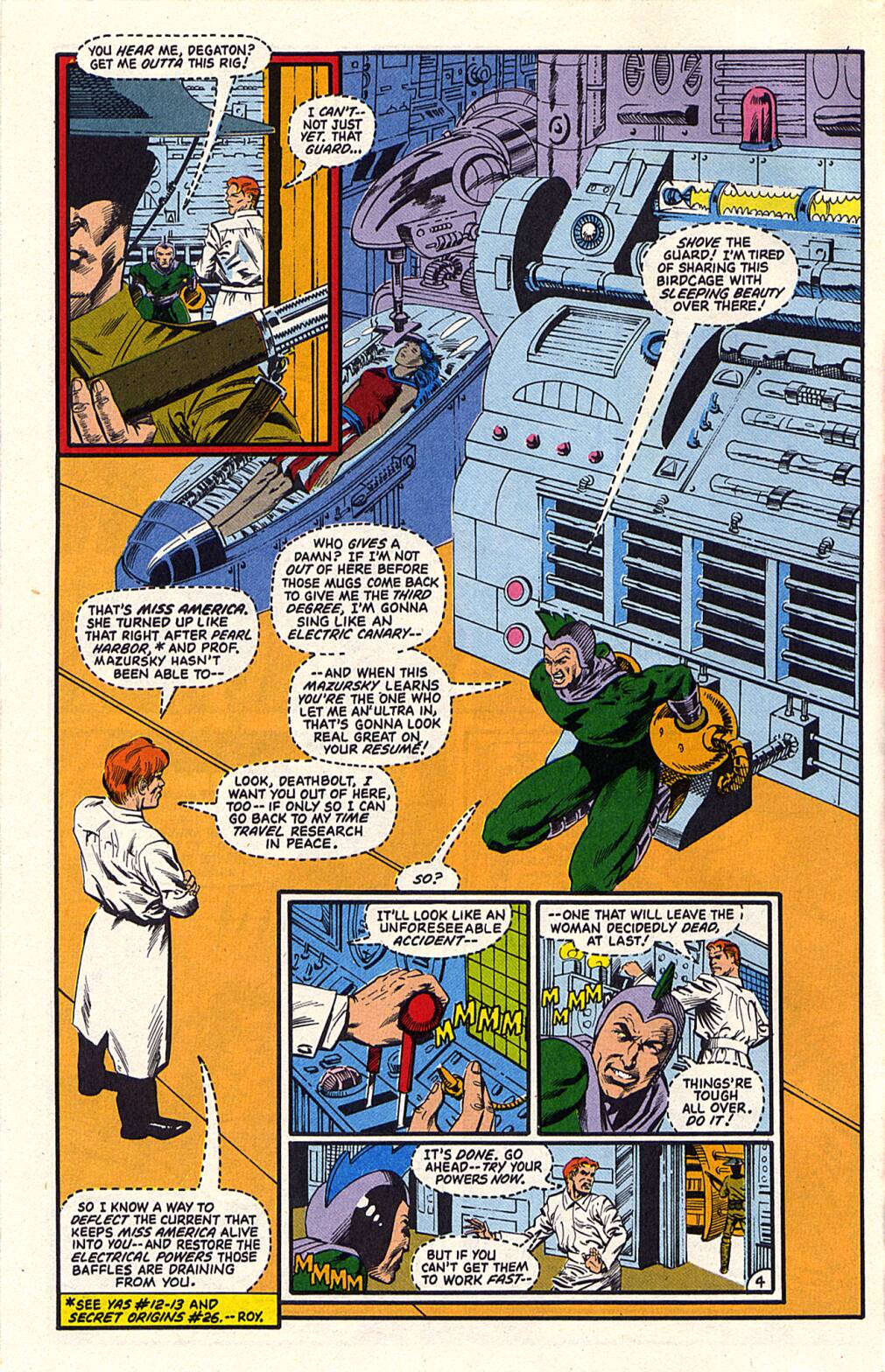 He kills some guards on the way out and starts collapsing the place. Miss America emerges, awake, then faints, then Amazing Man and Robotmoan shore up the place. Deggie runs into Mekanique, who has fixed his calculations and wants to talk. At the Perisphere, the kids get scolded by Liberty Belle and Johnny Quick and the adults search for Tsiphone and Ultra-Humanite. Amazing Man stays behind and reveals he now has magnetic powers, like in Fury's dream and wants to pursue things, with them. They make a pact to watch Mekanique closely. Chuck Grayson calls to say he has a brain-thing which might calm Tsiphone and the rookies decide to get it, without telling the adults. They split up and go off. Tsunami and Neptune Perkins locate Ultra-Humanite from the vibrations he is creating, smashing up a lab, hidden inside a cargo ship, during a tempter tantrum. Flying Fox locates Tsiphone on the balcony of the Chrysler Building. Arn distracts her while Fox clamps the helmet on her and then grabs Arn. Humanite smashes his way out and does a Godzilla impression, until he electrocutes himself and the helmet does the trick on Tsiphone, and the other two furies take her away, leaving only Helena.  The adults turn up and have words with thee....I mean them. An epilogue shows Deggie and Mekanique plotting, for the annual s for this series and Infinity, Inc. 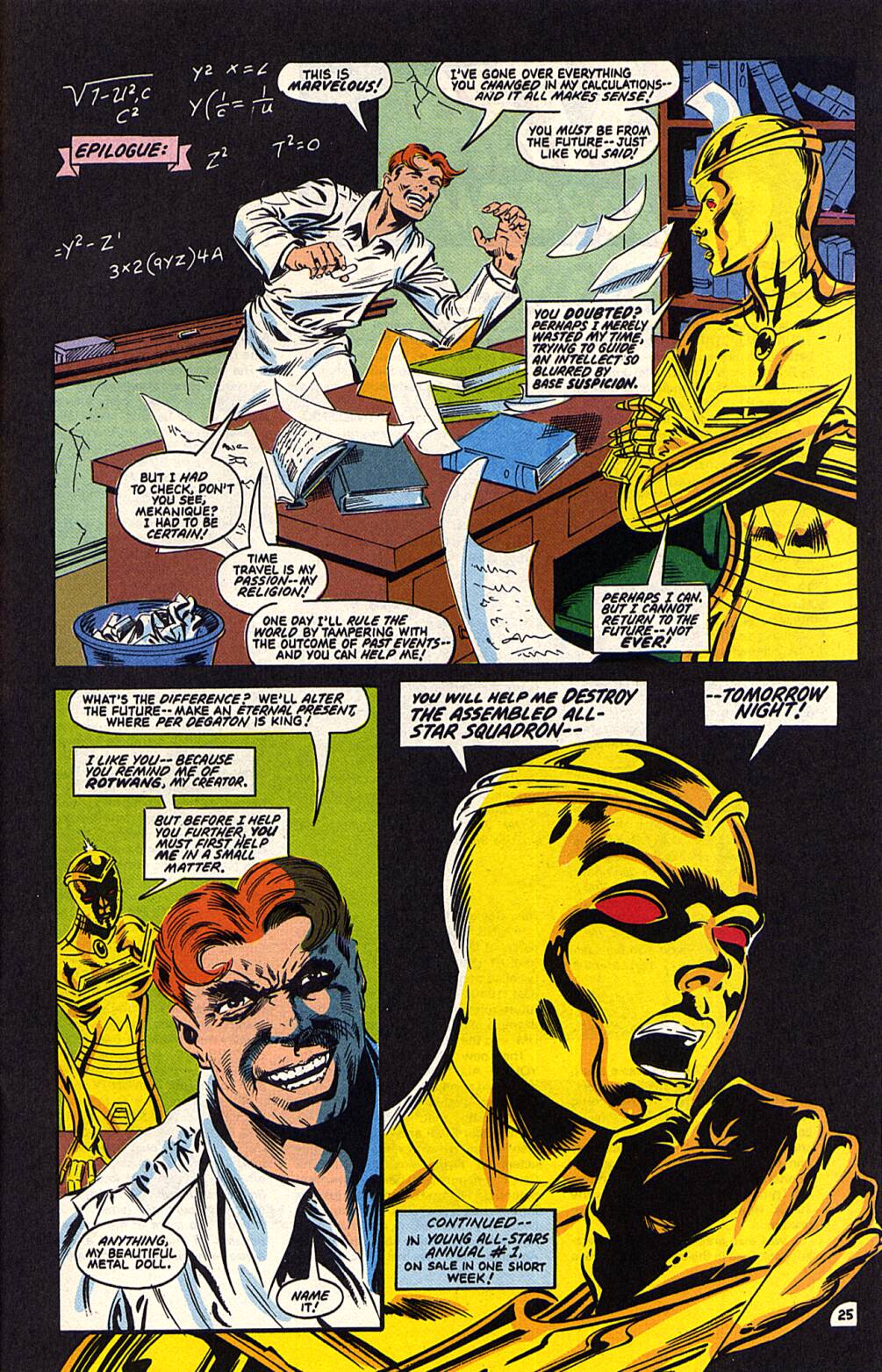 Thoughts: Thoughts: Blissfully over, in a decent issue. this kind of caps off the initial storylines; or, will, once the annuals are done. We finish up with Deathbolt, then move onto a new storyline. It's fine, if not spectacular. Humanite whines about not getting the giant ape body, but his later one wasn't as big as Kong. It would seem that Per Degaton will be working with Mekanique to bring about the alternate future, which is tied to Fury's dreams.
|
|
|
|
Post by codystarbuck on Jul 29, 2021 14:47:21 GMT -5
Young All-Stars #15 Creative Team: Creative Team: Roy & Dann Thomas-writers, Ron Harris-pencils, Malcolm Jones III-inks, Jean Simek-letters, Gene D'Angelo-colors, Mark Waid-Associate flunkie Synopsis: We start with a race between the ladies, in the Perisphere gym, which Fury easily wins, but it's against their individual times, not each other. The guys sneak in to watch and Dan cheers them on and whistles, while Fox is puzzled. Tigress shows off for Arn and isn't watching as she steers towards a dumbbell in the floor (careless weightlifters!) and takes a header towards the wall, but is intercepted by Fury. Tigress gets all catty (go figure) and Liberty belle tells them to hit the showers and tells the boys to get the hell out of her gym. This is then followed by a gratuitous locker room scene... 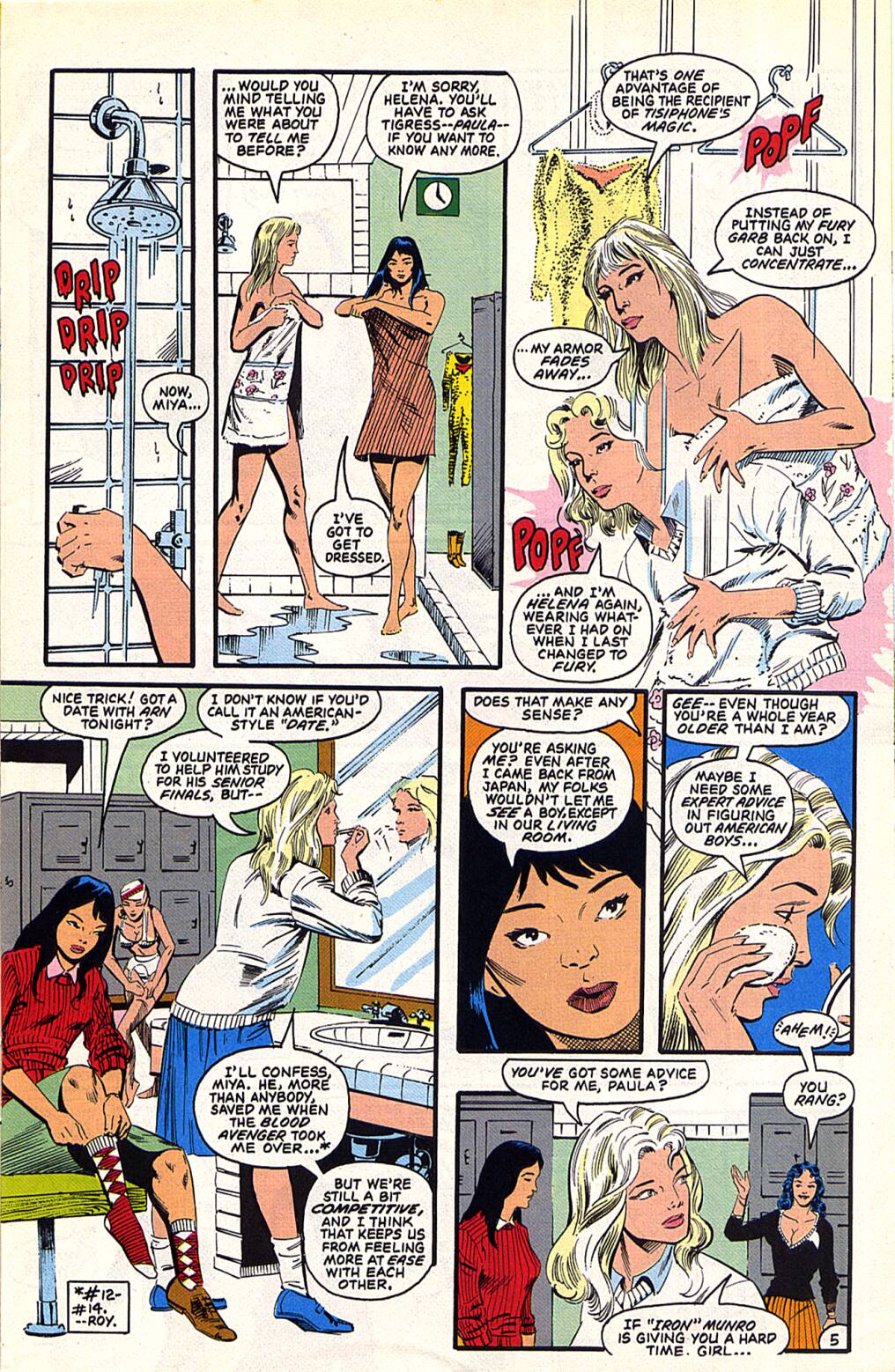 ...where Helena is asking Miya about dating advice and Paula basically says Arn would be more interested if she "put out." That leads to more snark and a dousing by Miya, to cool the two women off. After drying off, Helena goes and talks to "Uncle" Johnny, about male expectations on a date, and Johnny pretty much wets himself and has to be saved by Libby... 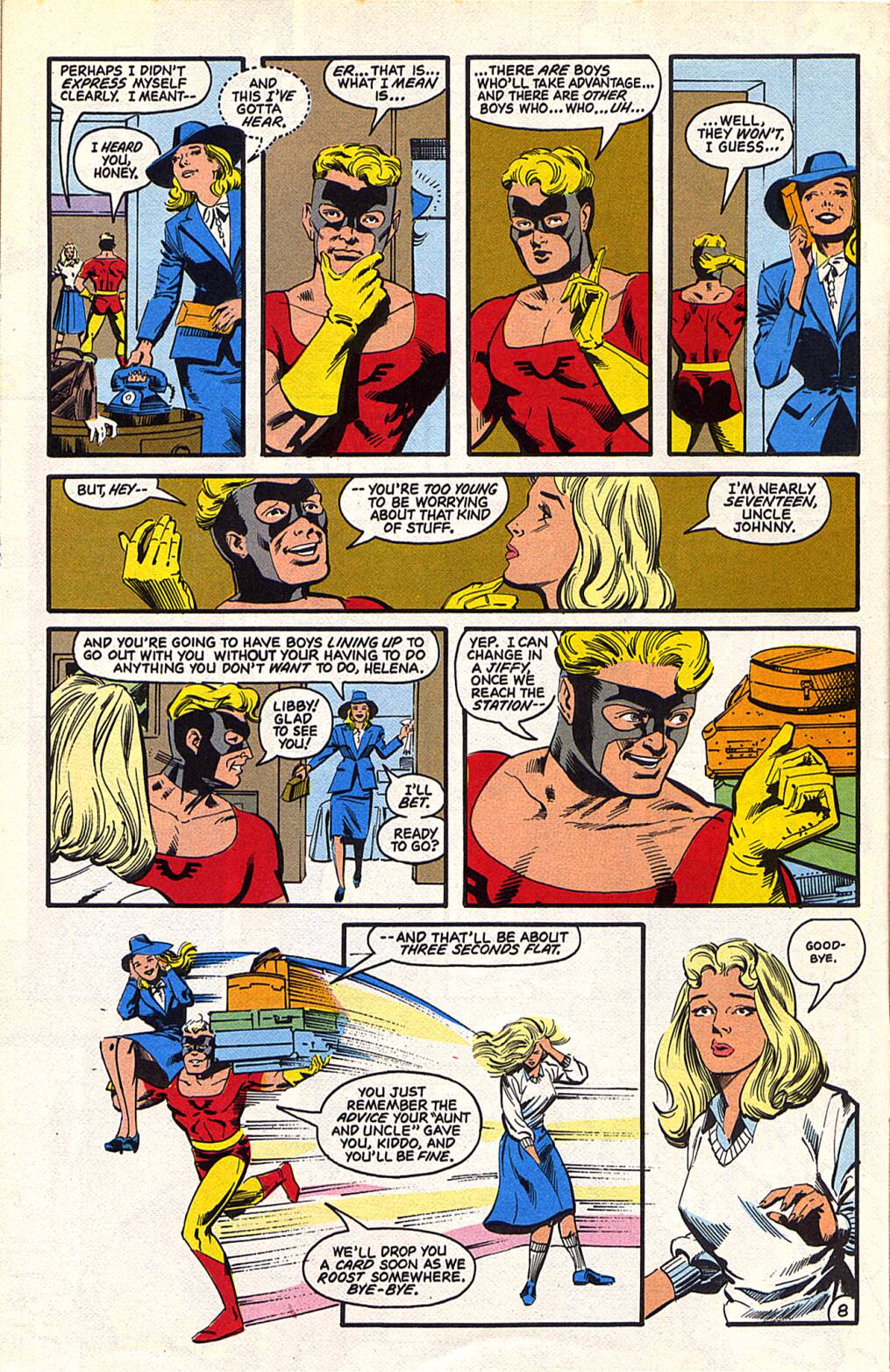 Everyone is studying for their finals, in the library and Helena concocts a study date, while Wesley Dodd and Sandy turn up with tickets to a jitterbug contest and Paula rounds up everyone to go have fun, leaving Arn and Helena to be chaperoned by Gernsback, while they "study." Helena plays the tease and Deathbolt turns up... 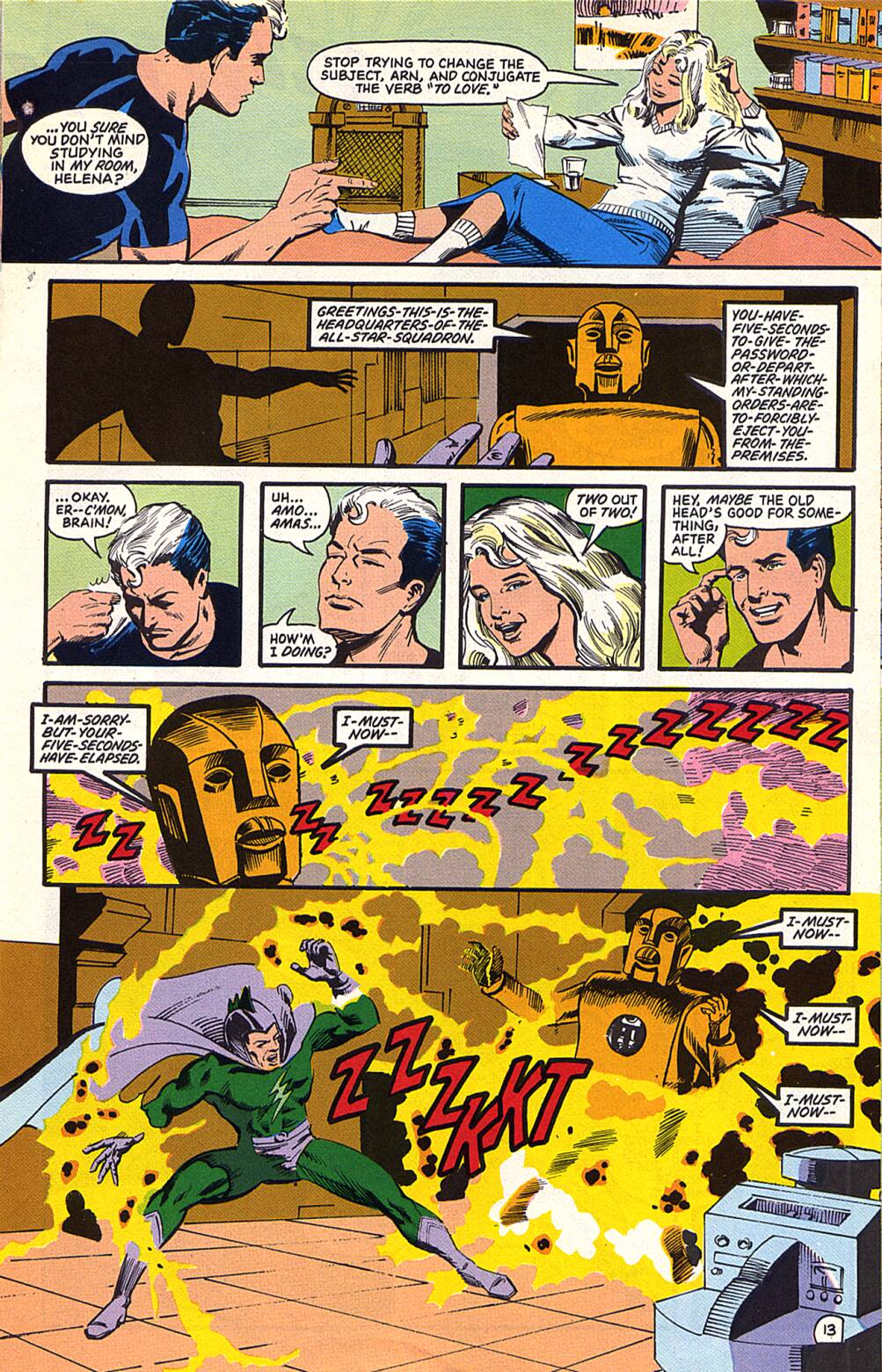 He neutralizes Gernsback, then runs into Arn and Helena and stuns Arn, but gets his clock cleaned by Helena....  He gets wrapped up in something non-conductive (I assume; they basically mummify him and Gernsback hauls him away) and then do a bit of dancing to the radio, as well as toss each other into furniture (well, Fury tosses Arn) and things are about to turn into an After-school Special, when the phone rings, interrupting unplanned pregnancies-in-the-making. It's Dr Charles McNider (funny, I've never heard of a Celt named Nider, especially one who had a son), telling Arn he has a "mild" case of VD. 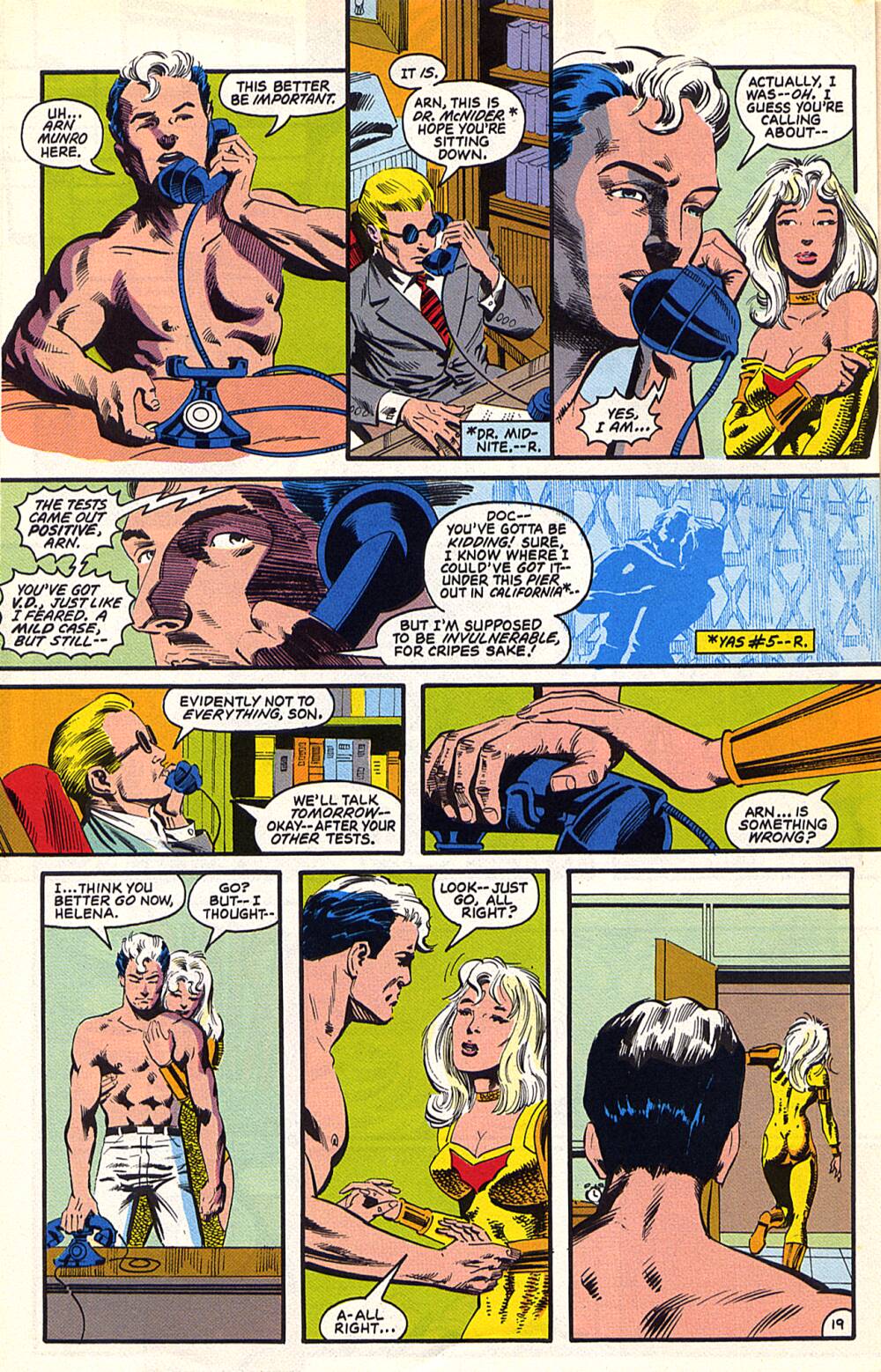 Arn is suddenly feeling less amorous (Thankfully) and goes off to mope. It's time for finals and Dr Mid-Nite delivers them, while everyone is in costume, for whatever reason. Arn walks out, in frustration and Doc says let him be. Fox finds him sitting on the roof of the Perisphere and they talk. Arn is worried about what Helena will think if he tells her about his VD. Fox gives advice and philosophy and basically tells him to finish his finals, then deal with the Helena problem. He goes back and finishes the test. Later, in Colorado, Arn receives his diploma and a surprise, as the rest of the gang are there to see it, and Dyna-Mite accidentally clashes his rings, while clapping, setting off an explosion. they all cheer and Arn apologizes to Helena, without telling her he has The Clap. Hopefully, he's been treated by Dr McNider, by this point. Roy never says. Thoughts: Well, Deathbolt was pretty much a bait and switch, as he appears and is taken in the span of 4 pages, while we are subject to a morality tale about teen sex and the potential consequences. I don't mind a social message, but this is pretty clunky. It makes the ABC After-School Specials seem subtle. Fury would have probably been played by Melissa Sue Anderson. Arn's VD is kind of set up, in that he has been shown to be quite the ladies man and there is enough suggestion of sex that you can believe he might contract something. More likely that he'd cause a pregnancy as the fact that he has contracted VD also suggest he isn't using contraceptives (though not a guarantee of preventing an STI). It is certainly a change from the last comic I saw with a VD message, which was the Lady Cop issue, of First Issue Special, where the dialogue was so vague you had to already have an awareness of sex and STIs to get the gist of what was being implied. That was a Code book, this is not. Nothing really bad about the issue; but, it kind of sums up my frustration with this series. We haven't really had much epic combat or really engaging character development. It's pretty heavy on dialogue and kind of cliched, in terms of character. It has fits and starts and never seems to gel, the way the original series did, or stuff like New Teen Titans. I also don't find the characters that compelling, as Arn and Fury are really the only ones being developed and the rest are playing stereotypes. Tigress gets the worst of it, since she is destined to become a supervillain, she must be portrayed as "easy" and "catty", instead of being a more complex person. James Robinson handled the character far better in The Golden Age. Deathbolt and Ultra-Humanite felt wasted, especially since they were part of one of the top 5 storylines in All-Star Squadron. They were a big threat there; here they were a minor nuisance, while dealing with rookies. That's lazy writing. Anyway, Neptune Perkins gets the spotlight, next, as we enter a 4-part storyline, which explains his background. His real background, beyond what was shown in All-Star and here. ps. Why does it seem that we see the girls in their frillies a heck of a lot more than the guys in their scivvies? Also, Paula's top seems to show waaaaay more cleavage than your average 1940s fashion.
|
|
|
|
Post by codystarbuck on Aug 8, 2021 17:54:19 GMT -5
Young All-Stars #16 Now, we explore Neptune Perkins and his family restaurant. Food's average but the pie is good! Creative Team: Roy & Dann Thomas-writers, Michael Bair-pencils, Malcolm Jones III-inks, Jean Simek-letters, Gene D'Angelo-colors, Mark Waid-Assoc Editor Special Thanks to Randy & Jean-Marc Lofficier, likely for help with the meta-fiction mythos within the story. Synopsis: In the Arctic, a Nazi submarine surfaces, with a team of goons and a scientist, Dr Thule. Un-huh; family name taken from a mythical place. 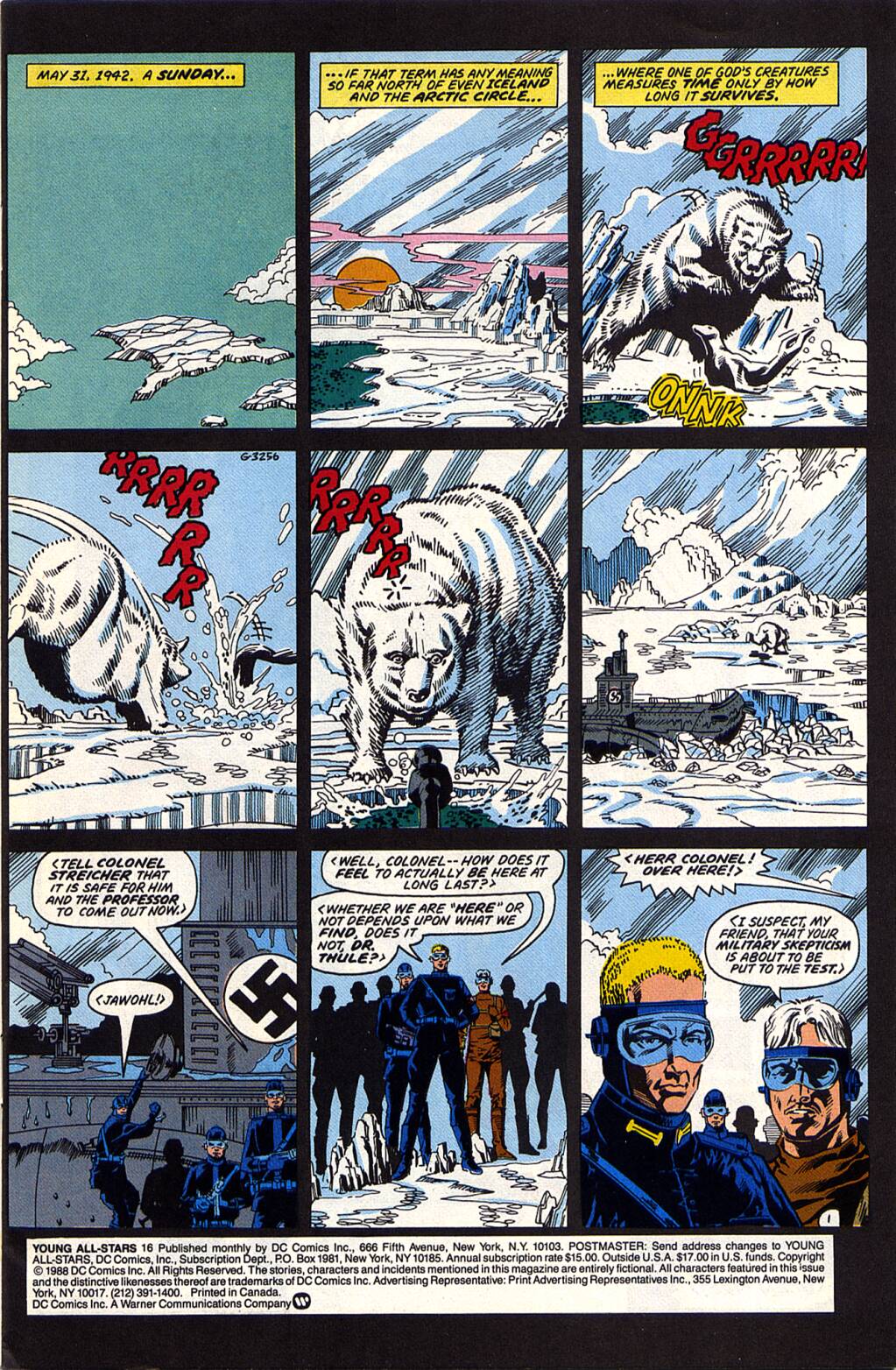 They appear to find Doc Savage's Fortress of Solitude and knock rather loudly on the door... 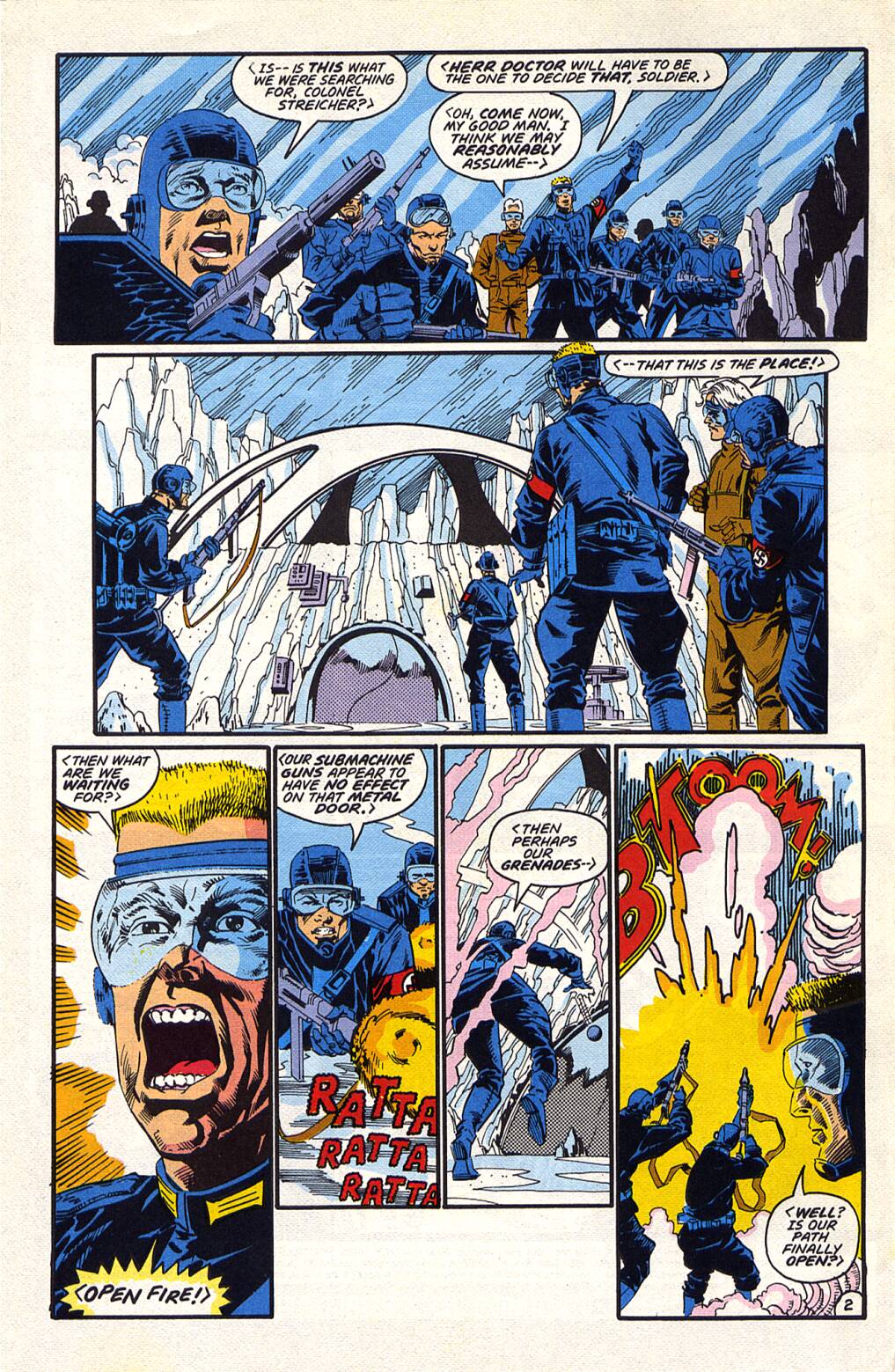 Out come skinny white dudes (and I mean pasty white) which they call the Dzyan and the Ratzis open fire. The Edgar Winter tribute act is hard to kill and take some goose steppers with them. The Nazis are better armed and cut through the reception committee and find a shaft that goes down into the heart of the artificial island, known as Leviathan. They then hunt for the alien energy that powers it; the Vril. The encounter one Arthur Gordon Pym (what, you think Stan conjured that surname out of thin air?), wo tells a Dzyna, named Kalla that it is time and she turns into a bird and flies away. The stormtroopers try to bring her down, but she escapes. At the Perisphere, Wildcat and Iron Munro are sparring, while others workout or watch. Ted's punches have little effect on Arn, but Fury ends up knocking Ted Grant for a loop, without meaning to, when she tries to interject. Then, the bird turns up and starts talking to Neptune Perkins, floating in his tank. It transforms back to Kalla, who tells perky that his grandpa needs him. Perky says his grandparents are dead and Kalla tells the truth of his past. Perky's grandpa is Arthur Gordon Pym, who sailed on a schooner, in search of sea lion pelts and other furs and ended up capturing a strange animal and meeting some dark skinned natives, who lead them to an island, where they ambush the ship and crew, with only Pym and Dirk Peters, a half breed, escaping. They climb a ridge and find strange hieroglyphs. Then, they ambush a solo native and steal a canoe and eventually encounter warm waters and a white powder. They are swallowed up in a mist and find themselves on a hidden island, where they meet the white dudes, who take them to the city Dzyan and show them wonders, including the Vril... 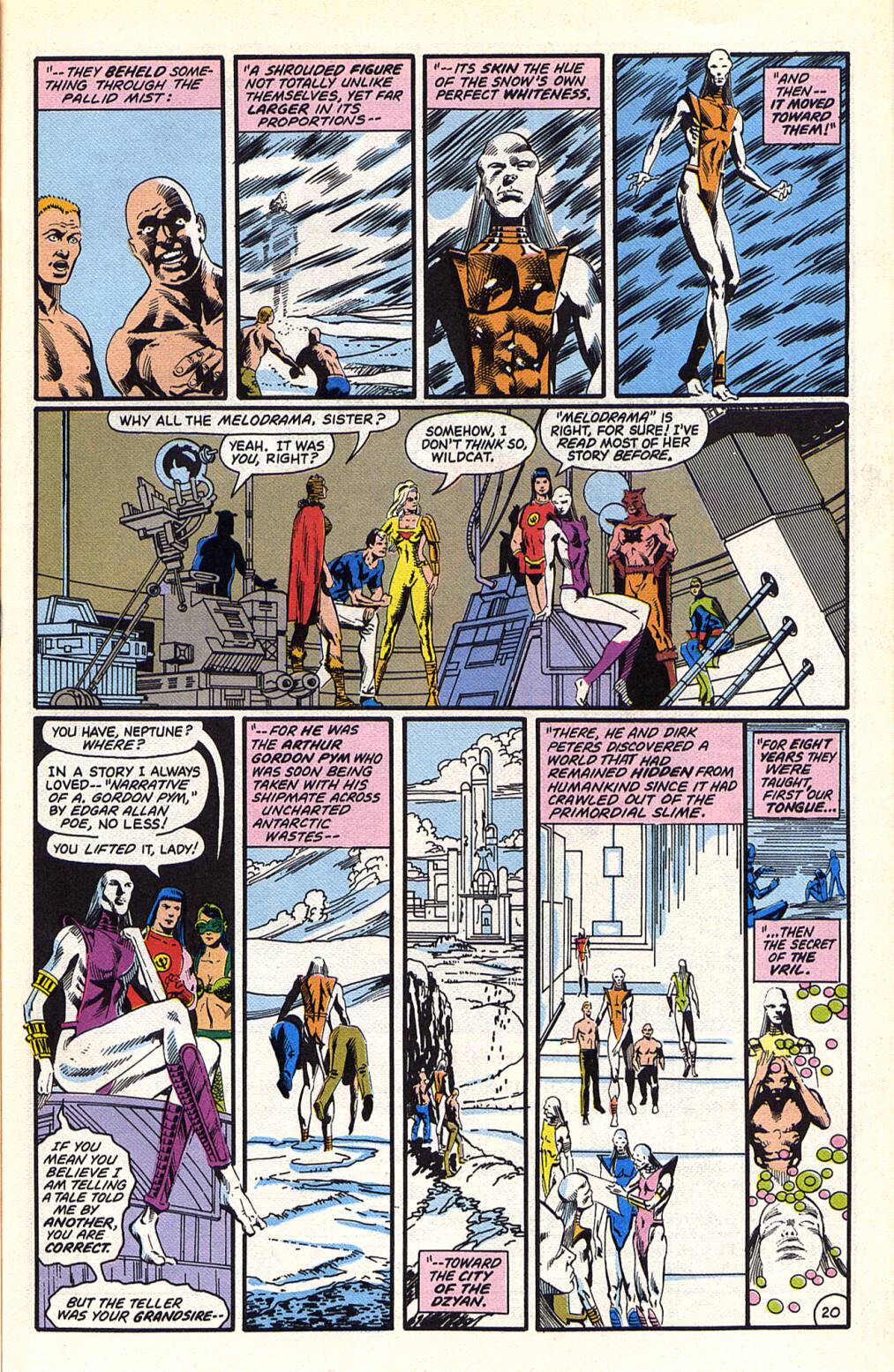 Perky has heard this before, in Edgar Allen Poe's "The Narrative of Arthur Gordon Pym." Kalla days it was real and that the Dzyan people taught Pym and Peters about Vril, which is a mental power. The humans eventually leave Dzyan and return to America, where Pym relates the tale to Poe. meanwhile, Madame Blavatsky had come in contact with a copy of the Book of Dzyan, which indicates most of the Dzyan fled tot he stars. Peters was furious with Pym for sharing the tale, as he hoped to become rich off their discovery. They fight with mental energies and Pym kills Peters. He then flees back to Dzyan and lives among them, taking Kalla as a mate. he later has them build a submerssible, called the Nautilus and uses it to attack ships of war, using the name Nemo.  He replenished his crew by taking people from ships, including the Mary Celeste. Eventually, the Nautilus was destroyed in a storm, but Pym survived and the tale was told and embellished by one Jules Verne. Pym returned to America, took a wife and had children and then the wife died. he returned with his son, but he was miserable there and Pym sent him to live back in America, where he grew and was schooled. Pym went to Germany and sold some secrets, in exchange for resources to build Leviathan, the artificial island and used it to sink the RMS Titanic and steal its cargo of gold. Ross Pym, now an adult, hears of his father and sails to the secret island he used, as Nemo and finds a Vril storage set up. he meets a survivor of the Titanic and they fall in love and have a child, Neptune Perkins. Now, the Nazis have Pym and Leviathan and he needs Perky and the All-Stars' help. Thoughts: Ton of exposition here, not to mention meta-fiction going on. Edgar Allen Poe wrote The Narrative of Arthur Gordon Pym of Nantucket in 1838, his only complete novel. It tells of Pym stowing away on a whaling ship and hs adventures, including eventually being rescued by the schooner Jane Guy, where he meets dirk peters and has adventures, including escaping a tribe of black men and venturing towards the South Pole. The Book of Dzyan was one of the alleged sacred texts that Madame Blavatsky had seen that formed the secret doctrine, which was the foundation of the Theosophy Movement, which she led, which later influenced pulp writer Talbot Mundy, whose own work would influence a generation of sci-fi and adventure writers, with everything from Indiana Jones, to RE Howard's El Borak, to Phillip Jose Farmer and his pastiche of Doc Savage and Tarzan, from A Feast Unknown. Thule was a mythic land to the far north, spoken of by the Greeks, which went on to be used as one of the many mythic hidden lands in fantasy tales, including the home of Prince Valiant and all kinds of mysticism, particularly in Germany, where the Nazis clung to myths that it was the origin of the "Aryan Race." Poe mentions it in his poem, "Dream-Land," in 1844. Roy weaves all of this together and throws in Captain Nemo, for 20,000 Leagues Under the Sea (which refers to the distance the Nautilus travels, not the depth, smarty pants!), at the suggestion of the Lofficiers, as Verne wrote a sort of sequel t Poe's Pym tale and it seemed right to ink them. They also suggested French writer, Jacolliot, which introduced The Vril. There are problems here, like the fact we seem to switch between the Arctic and the Antarctic, at the drop of a hat. Another problem is the sheer volume of exposition makes this issue slow as molasses. You have to have a pretty high tolerance for all of this backstory and you already need to care about Neptune Perkins to actually pick up the series and that wasn't a large crowd. I am at the halfway point on this series and I am struggling to finish it, because I just don't care about these characters and the art hasn't been anything above serviceable. There is no great visual stylist involved here, like All-Star Squadron or Infinity, Inc, and those series floundered, at times, but recovered. This just keeps not really advancing. I skipped this series, initially, as I had long ago stopped reading the original All-Star book, due to circumstances, but the later issues I sampled didn't make me snap them up. When young All-Stars premiered, it looked like DC was trying to reboot the whole thing and rewrite their Golden Age history, because of crisis and that is a large portion of what this series is. problem is, its not dealing with the key stuff in that history, just creating bland stand-ins for richer characters. It's not even Squadron Supreme level of stand-in, even. I'm a sucker for meta-fiction and will continue to see how all of this plays out. I've read Phillip Jose Farmer's Wold Newton stuff and the Lofficier's Tales of the Shadowmen anthologies and enjoy the heck out of them. I am currently re-reading Kim Newman's Anno Dracula series, which mixes in all kinds of stuff from film and literature. Still, this series needs a major jolt to bring it to life and endless exposition referencing earlier pulp fiction and Victorian fantasy adventure isn't enough, in and of itself, to provide that jolt.
|
|
|
|
Post by codystarbuck on Aug 22, 2021 16:28:40 GMT -5
I haven't abandoned this; but, I haven't exactly been motivated to finish things. I have been skimming ahead, and have decide I will review the storylines, as a whole, rather than individual issues, as it is getting to be a slog. Roy is filling these things with exposition and meta-fiction; but the actual plot of the main story is shorter than the backstory. It's not a good thing when Hugo Danner, Arthur Gordon Pym and Victor Frankenstein are more interesting than your main superhero characters; but, I think that speaks greatly to Roy's original motivation to do this set of characters, which is to create a continuity fix. It's obvious Roy cares more about these other stories than his own characters, so why should the reader care?
So, next time, we will cover the rest of the Dzyan Inheritance (which includes Victor Frankenstein and the Thule Society and other Nazi wackiness) before moving on. Then, we will cover the return of Axis Amerika and more with Hugo Danner and lost worlds. It's become clear how the Lofficier's have factored into things.
Sadly, the art is not going to improve drastically. Roy was never able to draw a really inspired artist and who can blame them, with all of the exposition they were stuck with? I think Roy would have been better served to explore his ideas in a pulp-inspired series, rather than trying to shoehorn them into a superhero series that existed to fix a gap in continuity that only Roy and a select few cared about.
|
|
|
|
Post by Slam_Bradley on Aug 22, 2021 16:48:16 GMT -5
I bought Young All-Stars to the bitter end, but it was completely from inertia rather than because it was actually enjoyable. It's one of the books that led me to stop buying for characters (in this case GA DC) and focus on good comics.
|
|
|
|
Post by Calidore on Aug 22, 2021 17:11:33 GMT -5
Roy was never able to draw a really inspired artist and who can blame them, with all of the exposition they were stuck with?
This is kind of what led P. Craig Russell to leave the Elric books--he complained in a CJ interview about Roy covering his art with words that just related what was in the art anyway.
|
|
|
|
Post by brutalis on Aug 23, 2021 15:58:06 GMT -5
I bought Young All-Stars to the bitter end, but it was completely from inertia rather than because it was actually enjoyable. It's one of the books that led me to stop buying for characters (in this case GA DC) and focus on good comics. I gave up several issues ago. Was just too dang slow for me and really wasn't enjoying any of these characters. |
|
|
|
Post by codystarbuck on Sept 1, 2021 16:12:43 GMT -5
Alright, this is it. I've delayed and delayed; but, I'm putting this series to rest. I can't take the mediocrity of the Young All-Stars anymore. This will be a summary of the final storylines and a critique of what the series did well and why it failed. Issues 17-19, "The Dzyan Inheritance"   Neptune Perkins was conceived by the son of Arthur Gordon Pym and a survivor of the Titanic, under the radiation of a Vril battery. he was born a mutant, with webbed hands and feet and the need for salt water, to live. His parents were murdered and Kalla reveals the kilelrs were agents of the black order, the Nazis who have seized control of the artificial island, Leviathan. Neptune follows Kalla to Leviathan, then is betrayed by her. She wants his blood to revitalize Arthur Gordon pym and has conspired with the Black order to do it. She is murdered by Oberst Streicher, as the Black order intend to use the power of the Vril to conquer the world. The rest of the Young All-Stars, with Wildcat, follow in an Aircuda (an experimental fighter design that never went into service). Perkins is tortured to force Pym to reveal the secrets of the Vril. Dr Thule then recounts the history of the Black Order (aka the Thule Society), which rose into the highest ranks of the Nazi Party. Thule tries to absorb the Vril, then the Dzyan turn up to fight the Black order, then the Young All-Stars arrive. then, the still alive Kalla, who was dumped into the ocean, bumps into an island where Frankenstein's Monster hangs out (calling himself Victor Frankenstein II). Thule controls the Dzyan, via the Vril and they capture the Young All-Stars. Kalla is healed by Frankenstein and returns to disrupt Thule's control of the Dzyan. They fight and the Black Order are defeated and the Dzyan return to the stars. Arthur Gordon Pym dies aiding the Dzyan.  Issue 20 relates what happened to Helena Kosmatos, when she fell into the crevice and more about Tsiphone. It also reveals the history of Flying Fox's people and links him to Arak, Son of Thunder.      #21-25, "Atom and Evil" #21-25, "Atom and Evil"The Nazis and the Japanese work together to disrupt the Manhattan Project, with attempts to kidnap Leo Szilard and Albert Einstein. We see Baron Blitzkrieg unit with Sumo, the Samurai. They meet a group of Allied heroes (Squire, Phantasmo, Fireball, and Kuei). Baron Blitzkrieg and Sumo unite Axis Amerika and dispatch them to capture the scientists of the Manhattan Project. There is a long battle with Axis Amerika and Tirgress appears to die; but, gets better. Ubermensch reveals that Hugo Danner is his father, too. Arn nearly kills him; but is stapped by Gudra, who pleads for his life because she loves him. Fury is aided by Tsiphone.   26 deals with the aftermath of the battles, as people heal and face wartime prejudices. 27 features various Golden Age mystery-men in battle and Fury having to stay behind, as Dr Fate and Spectre go into Europe, via a special spell, to try to break the power of the Spear of Destiny.     The last 4 issues deal with the still living Hugo Danner, who is in the Lost World, in South America. Arn goes down there to investigate, along with the granddaughter of Professor Challenger, Georgia. They find the Lost World and Hugo. He lives with a group of natives that he has injected with his father's serum, in utero. His native brood turn on them and go off to conquer the world, their right, as the strongest. Hugo sides with them and the combined might of the All-Star squadron stops them and Hugo commits suicide. Thoughts: Roy tried to keep the All-Star Squadron going, by appealing to the crowd that read New Teen Titans and X-Men, while also filling in continuity gaps created by Crisis on Infinite earths. Problem was, most of the audience wasn't hung up on the continuity problems, as they hadn't read and loved All-Star Comics. they were too young and the back issues went for a pretty penny. More of us cared about the modern earth 2 characters who were lost, like Huntress, or whose histories got messed up and got shuffled around between "new origins." The world still had Superman, Batman and Wonder Woman; so, why should we care about Arn Munro, Fury and Flying Fox? Roy never gave us enough a reason to do so. of that threesome, Arn Munro was probably the only necessity, though you could argue that Fury was needed, to give birth to the later Fury, of Infinity, Inc. Fury started off with an interesting hook, but it kind of fell apart after the first year and she became little more than a love interest. Arn had some compelling material; but, more in his parentage, via Hugo Danner. That was an inspired idea; but, beyond that parenthood, Arn was kind of a dull character whose defining trait was being smooth with the ladies, which earned him a dose of the clap. The characters just never really gelled and didn't really grow. Dyna-Mite went from morose, bigoted sidekick, to cheery, explosive sidekick. Tigress had potential, but nothing was done with her, apart from crafting a weak love triangle with her, Arn and Fury. Flying Fox was a concept, rather than a character and linking him to Arak did add anything, especially since it came so late in the life of the series. He was the only "adult" character of the bunch, but he was also the least developed and too much of his story was stereotype. Neptune Perkins never rises above being a second-rate Hydro-man, which puts him way behind Aquaman or Namor. A Grade D water hero. the Dzyan Inheritance was supposed to give him depth; but, it jets meant endless exposition and the YA looking like chumps for seemingly endless issues. In the end, Arthur Gordon Pym was more interesting than his grandson, Neptune Perkins. Roy actually had a good idea in using past pulp literature to establish the foundation of the 1940s mystery men, since the pulp heroes inspired the comic book heroes. The problem was that the pulp characters were more interesting than the mystery men Roy created or adapted. I'd have much rather read an epic series about Arthur Gordon Pym, Frankenstein's Monster, Hugo Danner and Professor Challenger than Iron Munro, Fury, Dynamite, Flying Fox, Neptune Perkins, Tsumani, and Tigress. Thankfully, down the road, Alan Moore demonstrated how cool a metafiction comic could be, in the right hands. Roy dabbled some more in that, as did the Lofficiers, to better effect, in various Elseworlds projects. That was the other thing; too many characters. Only Iron Munro, Tsunami and Fury have much agency and you are left to wonder why we need the rest. As it stood, their background was more interesting than they were. Where the series really fails is in the art. Apart from Michael Bair, the series really lacked a great artist. Too much of it looked rather amateurish, especially compared to what was being done in other books, at DC; not to mention, in the indie world. It became clear that no artist of name value wanted to work on the series and Roy never really tapped into another Jerry Ordway. It really never rose above the level of the Charlton Bullseye; but, this wasn't a fanzine. Roy really struggled with the post-Crisis world, as it greatly affected his beloved stories and he couldn't let it go. He had political problems at DC and he eventually left, when he'd had enough. cCan't say I blame him; but, by the same token, I wasn't sorry to see him go. The longer Roy's tenure lasted, the less I cared about his material. The spark just wasn't there, like it was in the beginning. By contrast, when Roy left and began producing Captain Thunder and Blue Bolt, for Hero Comics, I thought the series was fantastic. Roy was better able to mix the comics of the past with a modern take and made a much more compelling group of characters. It was everything Young All-Stars was not. Back in the 1980s, I didn't think enough of Young All-Stars to pick it up and time hasn't improved that opinion. I gave it a go, to continue the All-Star Squadron look; but, it just didn't match up to even the worst issues of All-Star Squadron. Maybe that was the problem, as the latter issues of All-Star Squadron hadn't been much to write home about, especially Roy's obsession in retelling the JSA in Space story, for an audience who didn't care. It seemed like Roy just started writing for himself. Once in a while he was inspired, like the baseball issue, which was at least fun, or the Monster Project, which had more potential than most of what we got. Roy did it better in Invaders and, to a lesser extent, All-Star Squadron; but, he needed guidance from outside, but set himself up so that was impossible. I side with Jim Shooter that a writer really shouldn't be their own editor, as they can't be objective about their work and I think Roy's DC work demonstrates that more than his post-EIC work at Marvel did. I think if Roy had been given license to recreate the Golden Age history of DC, from the ground up, he would have been more inspired to do something great, though whether he would be able to let the minutiae go is another question. In the end, I felt that James Robinson had a better handle on revisting the past, with a new take that both honored what had been done, but adapted it to a more modern sensibility (Golden Ager, JSA, Starman). I think he was better able to see the flaws in the old comics than Roy and also find the cooler ideas that could be expanded. Well, except Madame Fatal, since he still treated that as a homophobic joke. So, here endeth The Young All-Stars and Roy Thomas' trip through Golden Age DC, for a few months of 1942. Do you realize, by the end of this, we had only done from December 6, 1941, to June, 1942? 7 months in 8 years! |
|
|
|
Post by mikelmidnight on Sept 3, 2021 11:23:11 GMT -5
The last 4 issues deal with the still living Hugo Danner, who is in the Lost World, in South America. Arn goes down there to investigate, along with the granddaughter of Professor Challenger, Georgia. They find the Lost World and Hugo. He lives with a group of natives that he has injected with his father's serum, in utero. His native brood turn on them and go off to conquer the world, their right, as the strongest. Hugo sides with them and the combined might of the All-Star squadron stops them and Hugo commits suicide.
I thought this was a terrible character assassination of a great and foundational character.
|
|





















